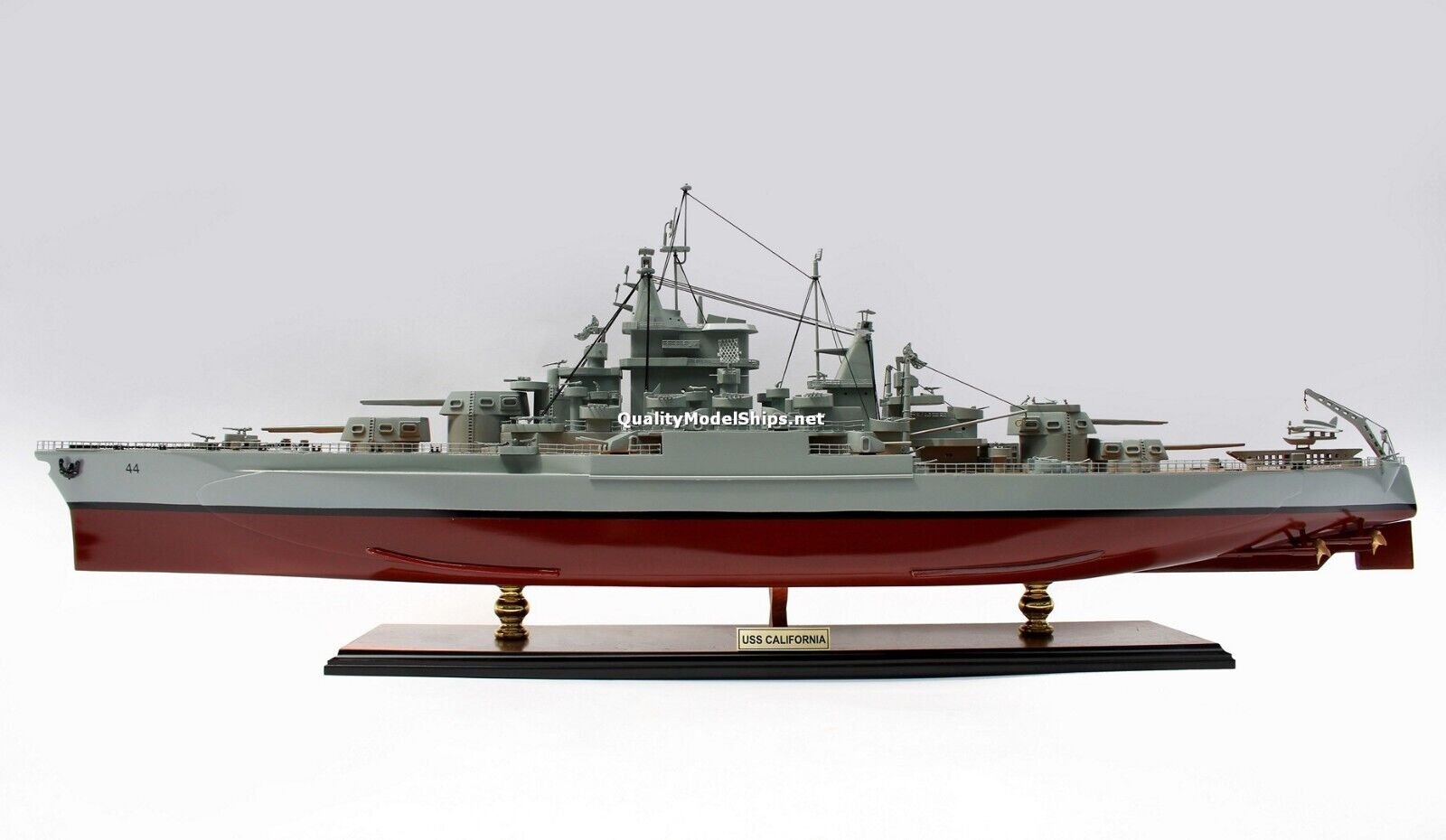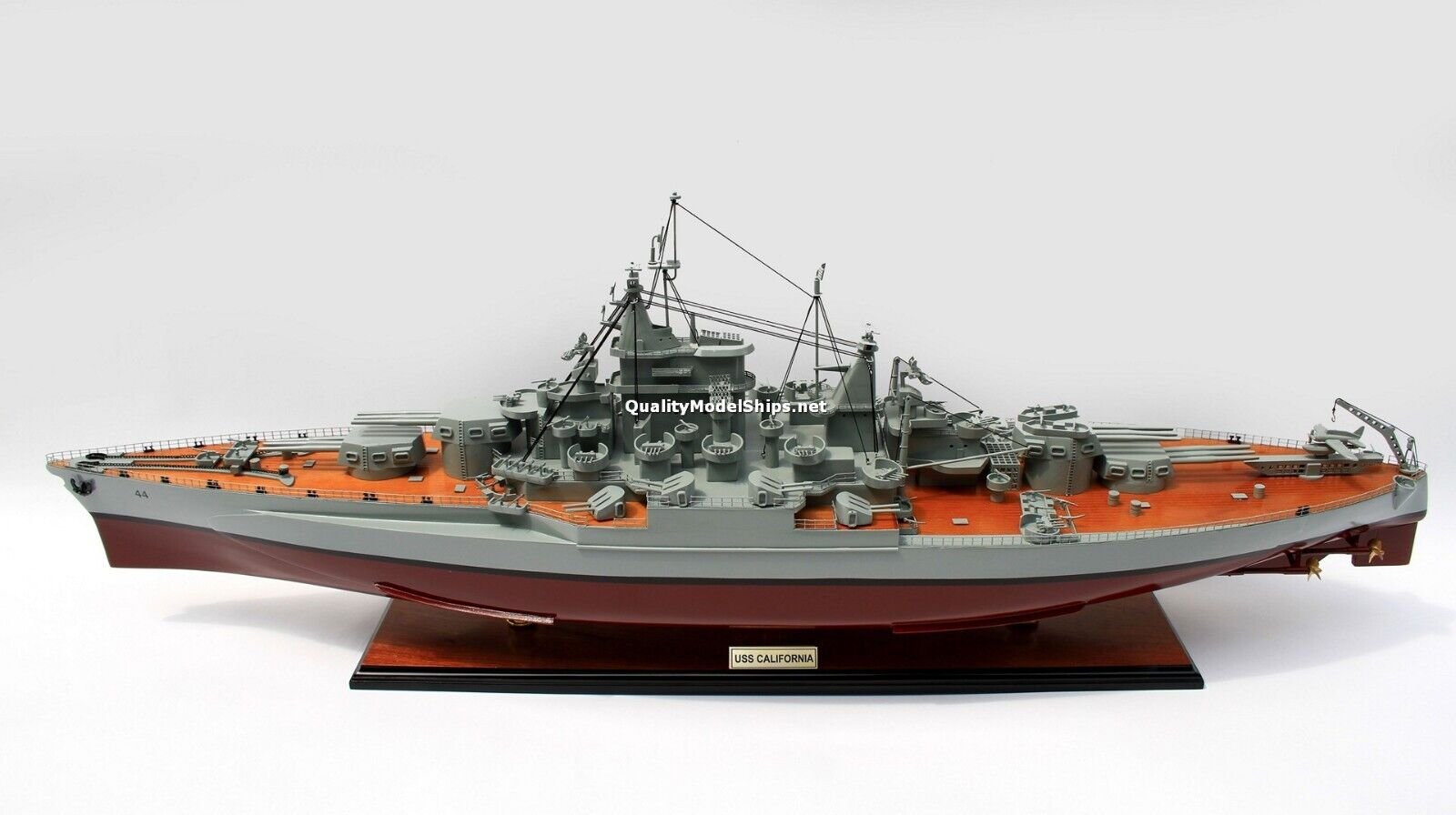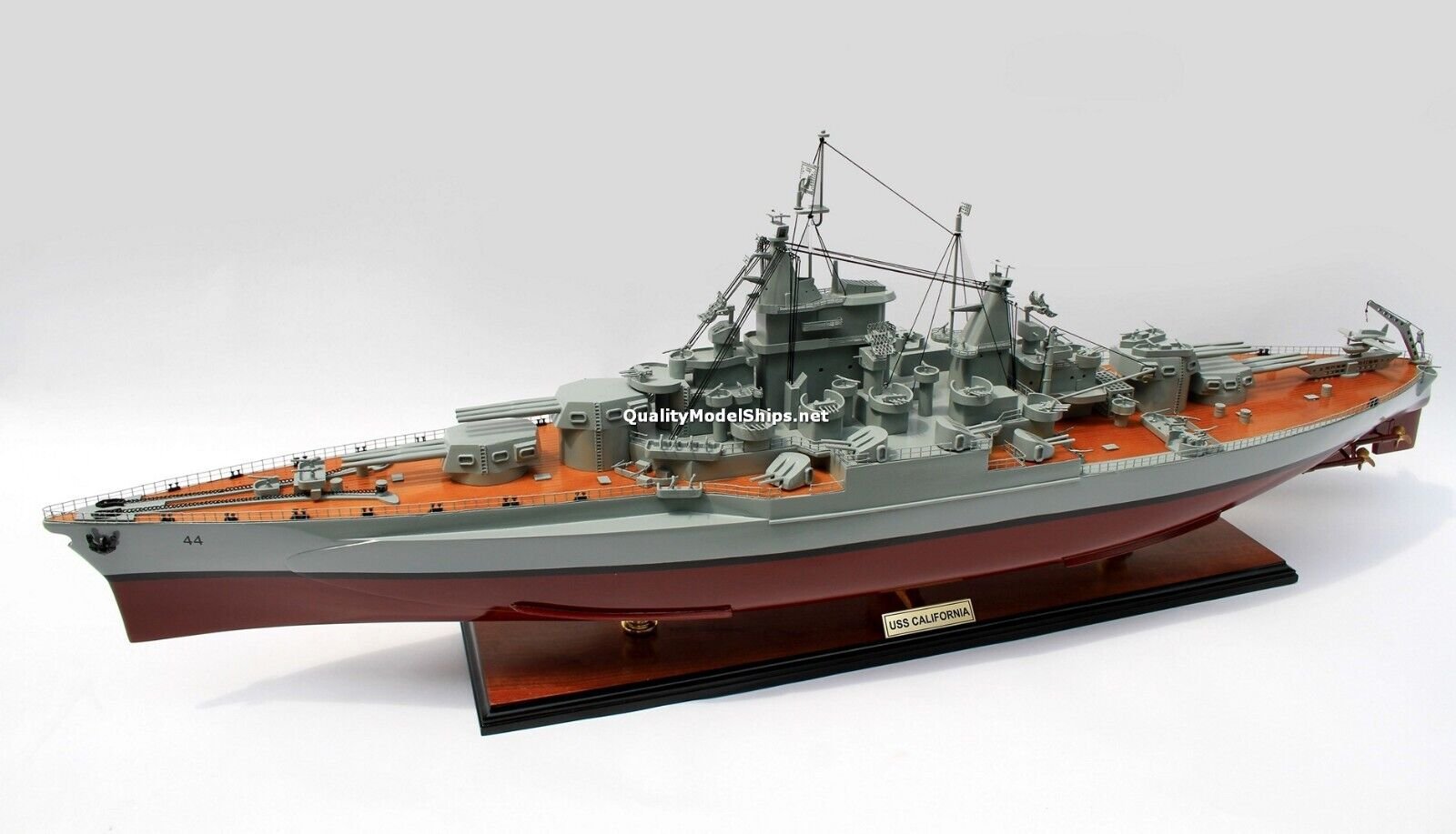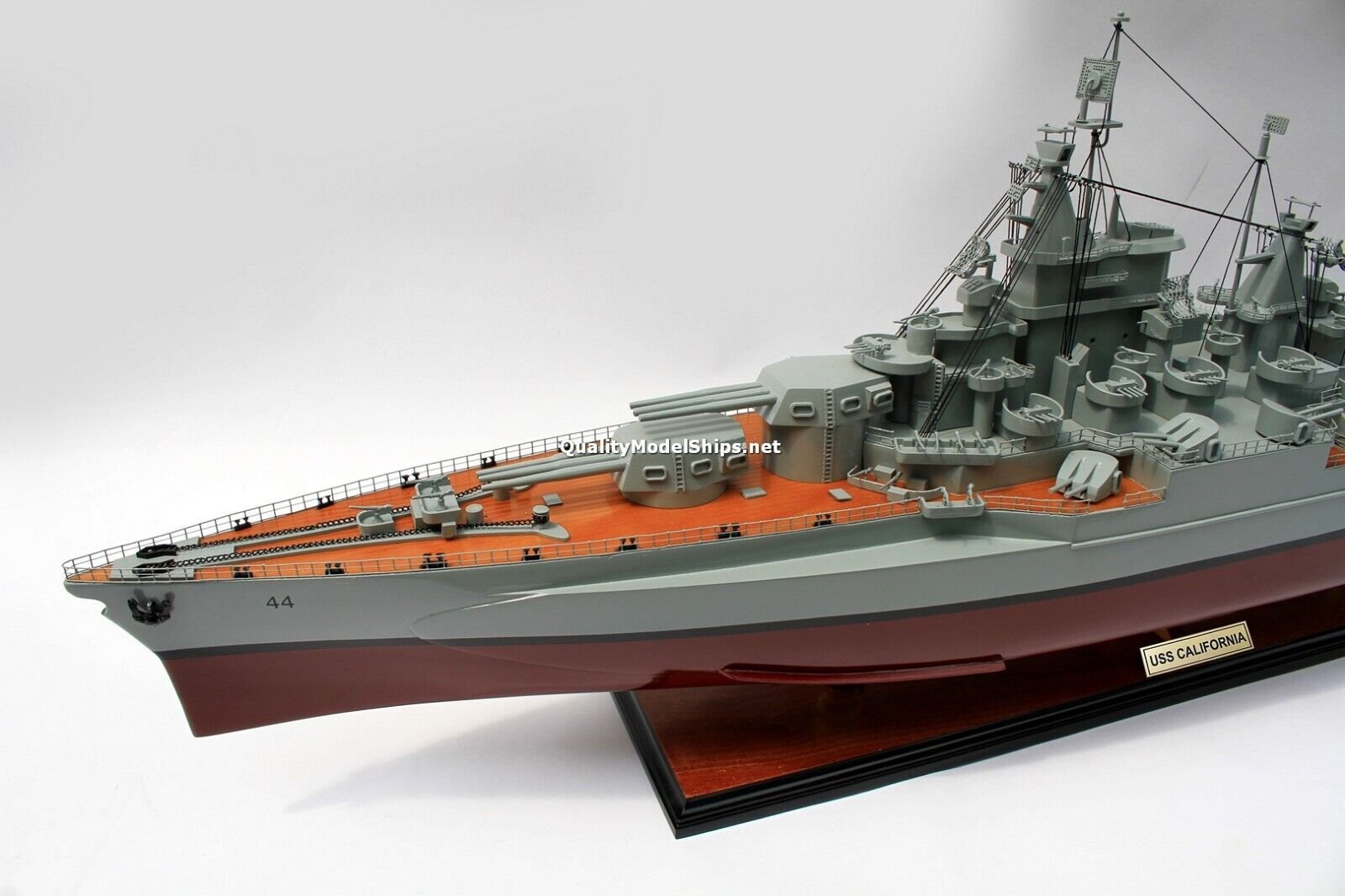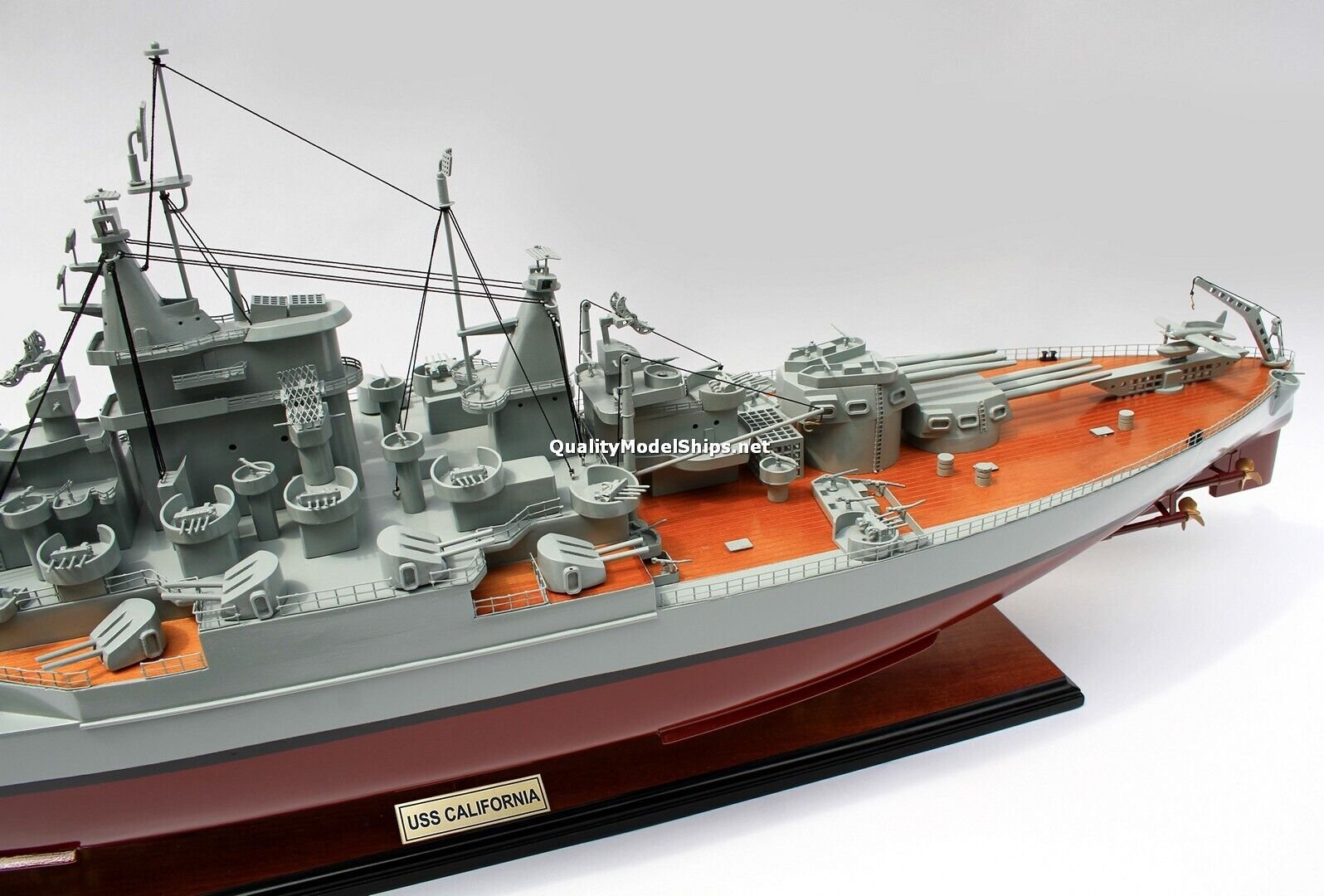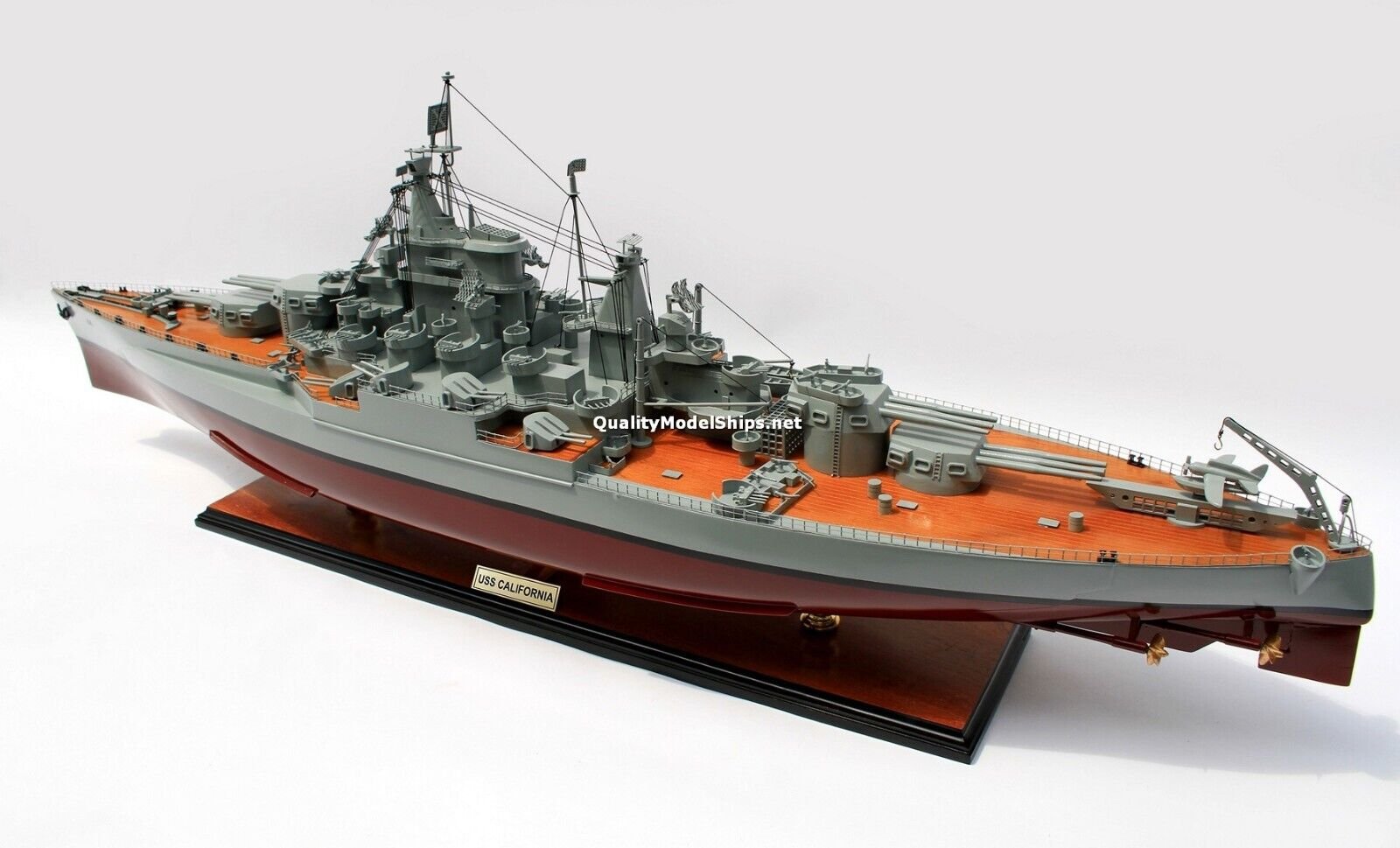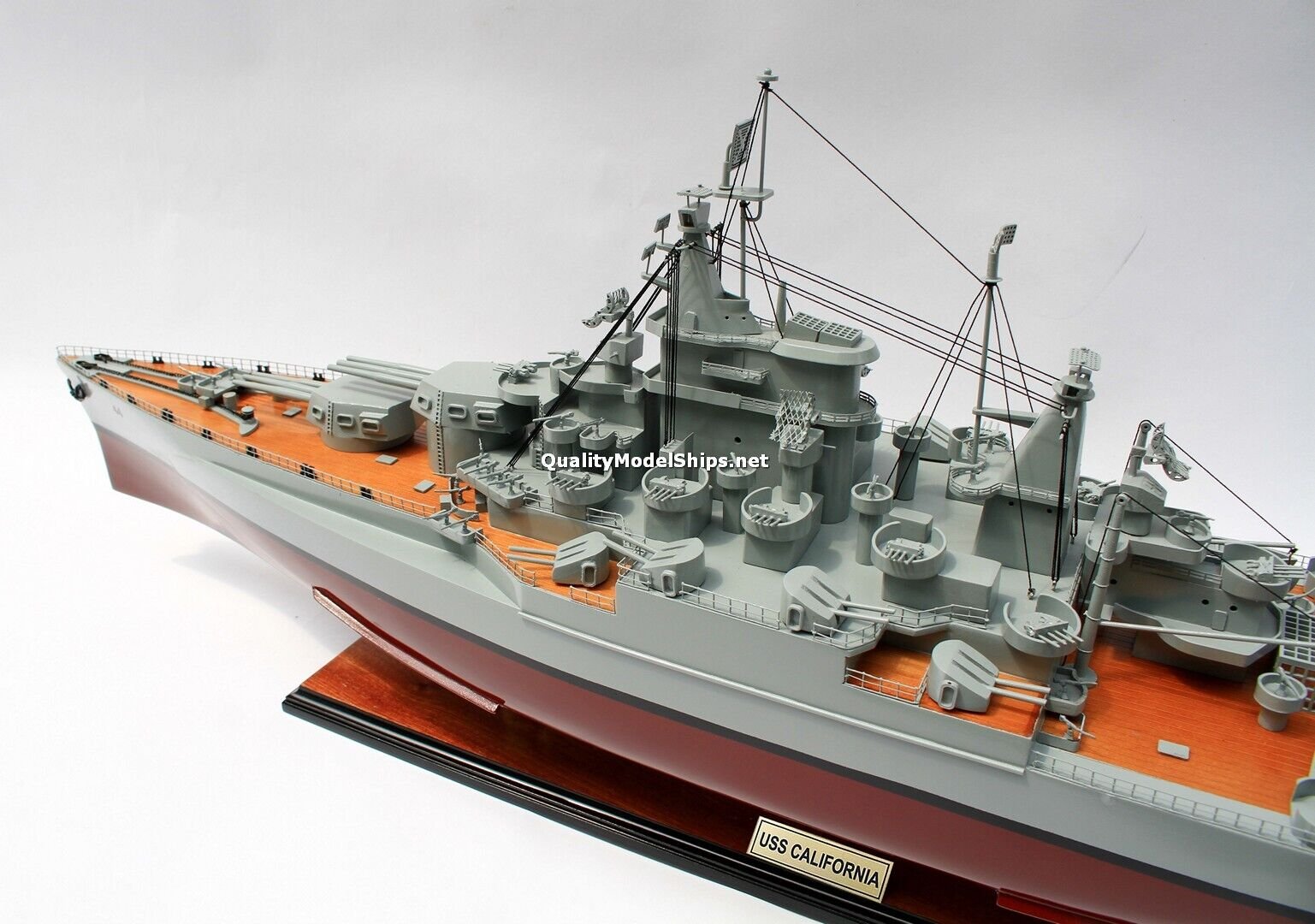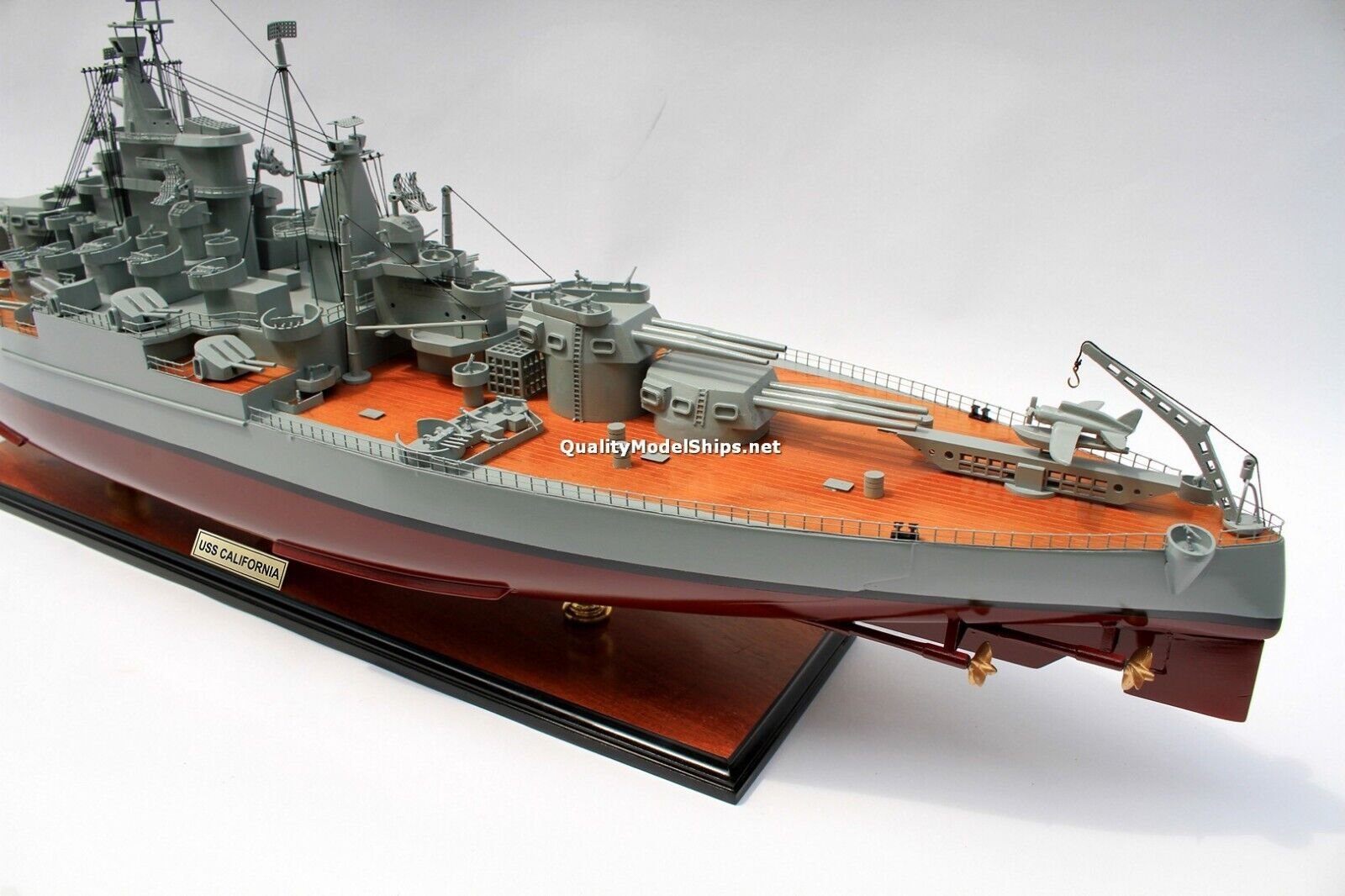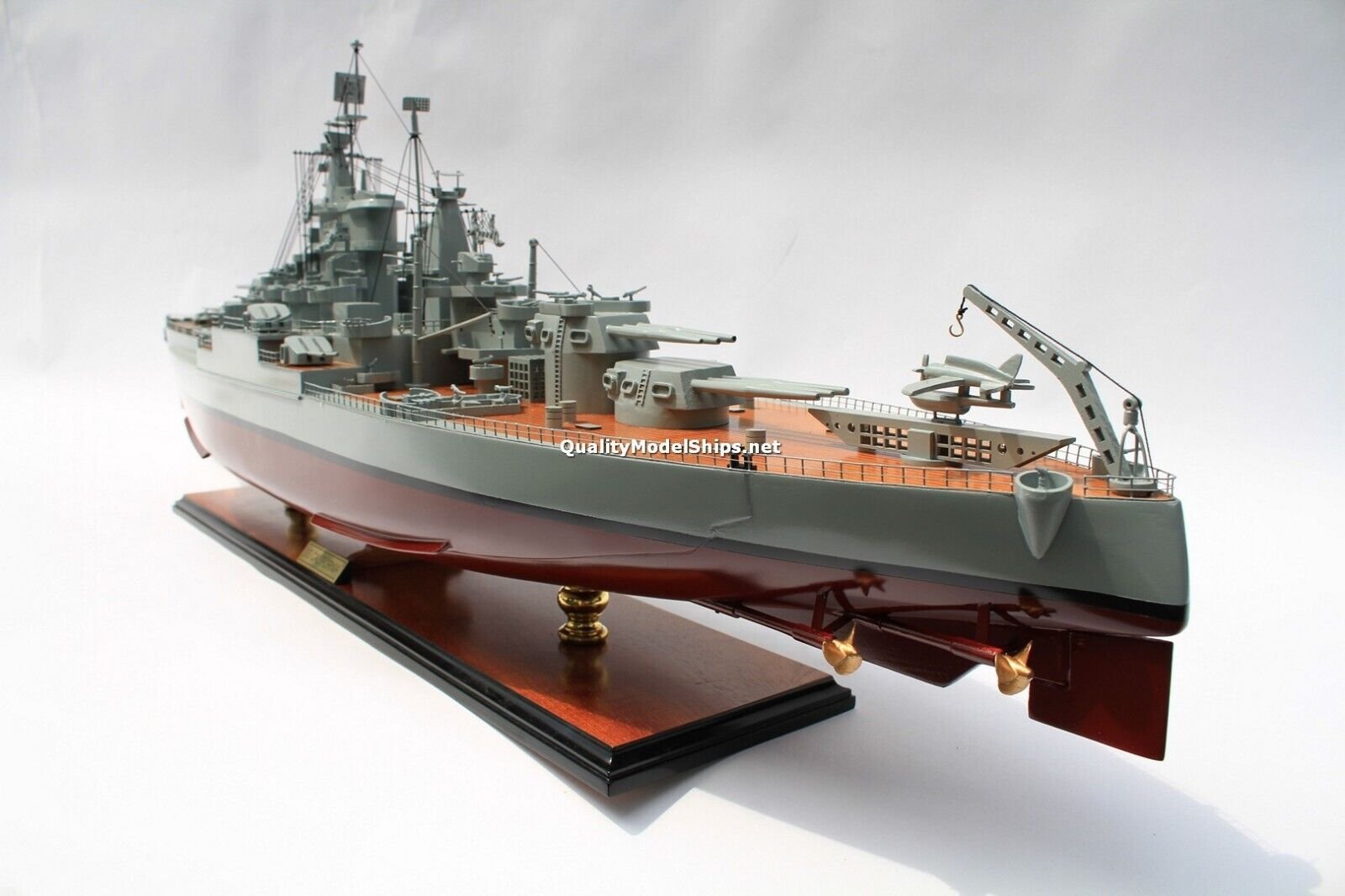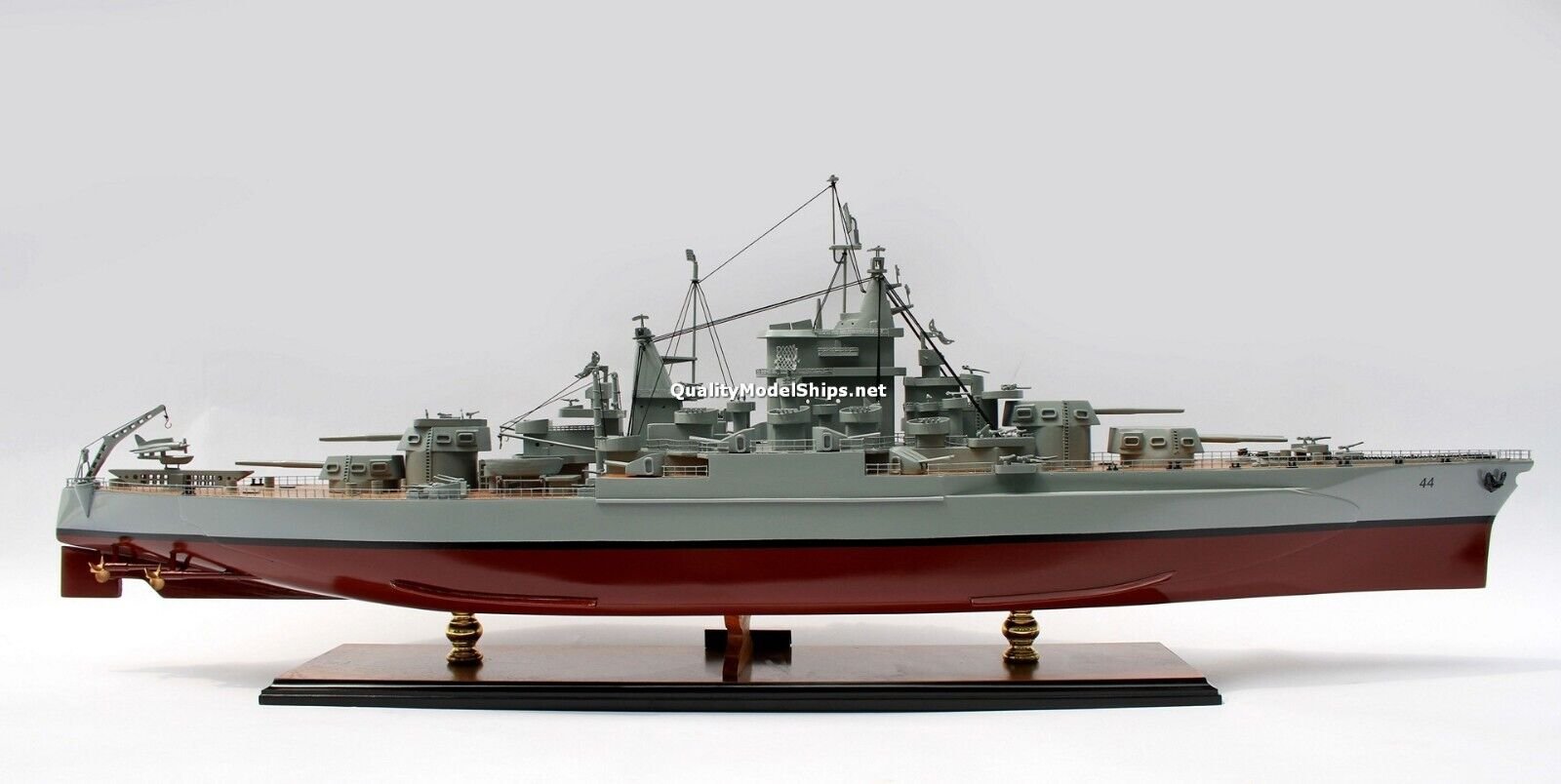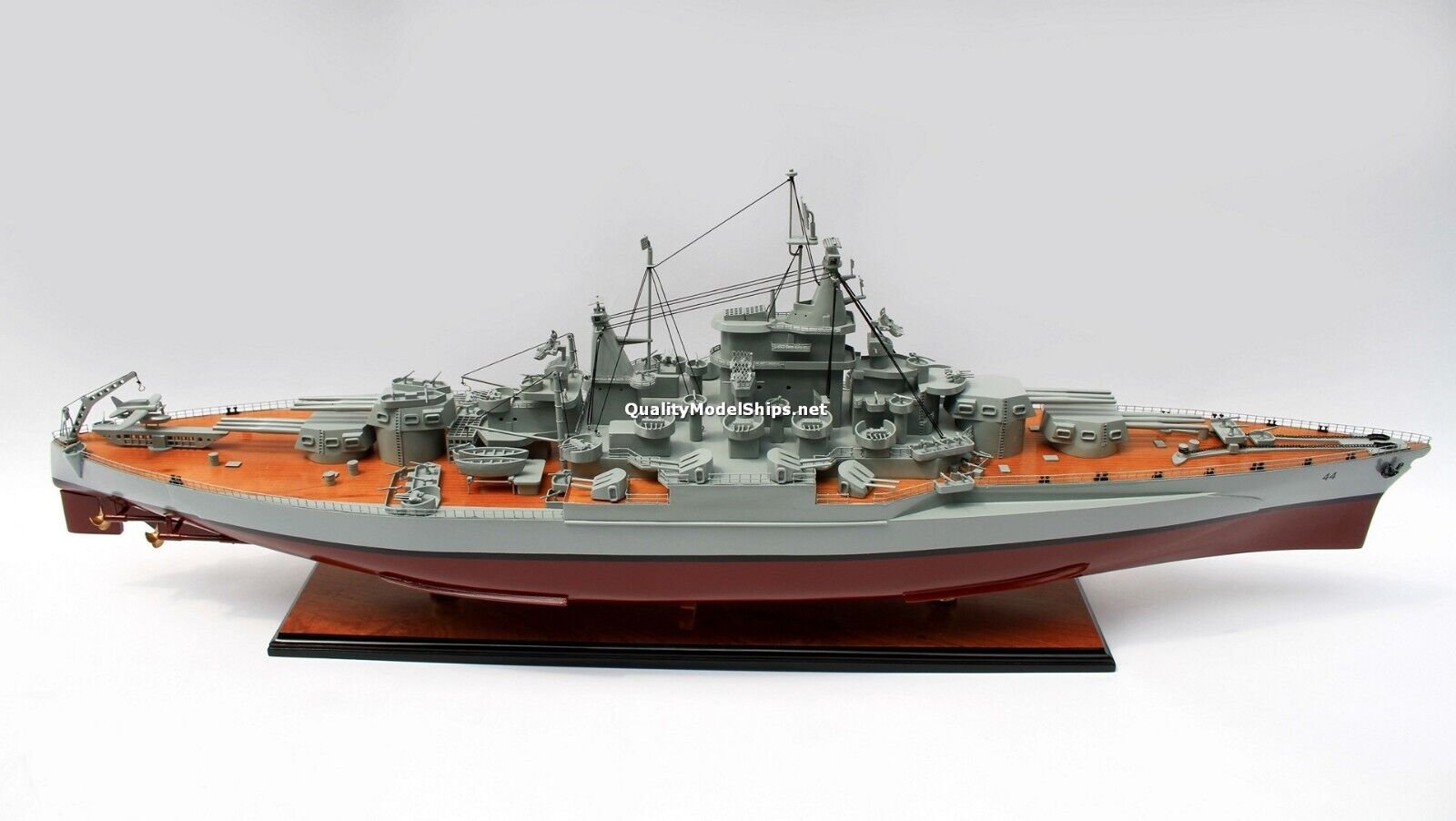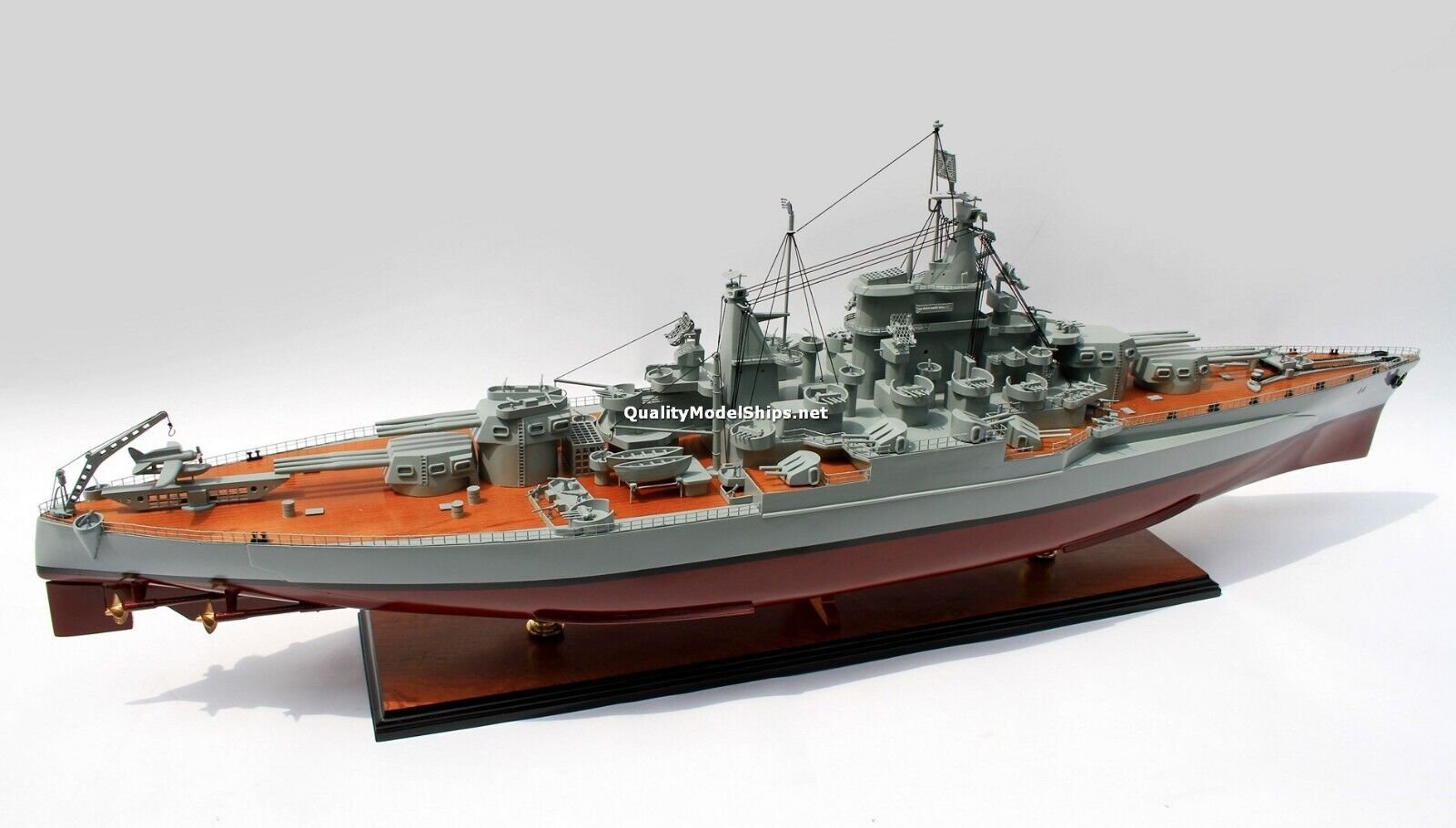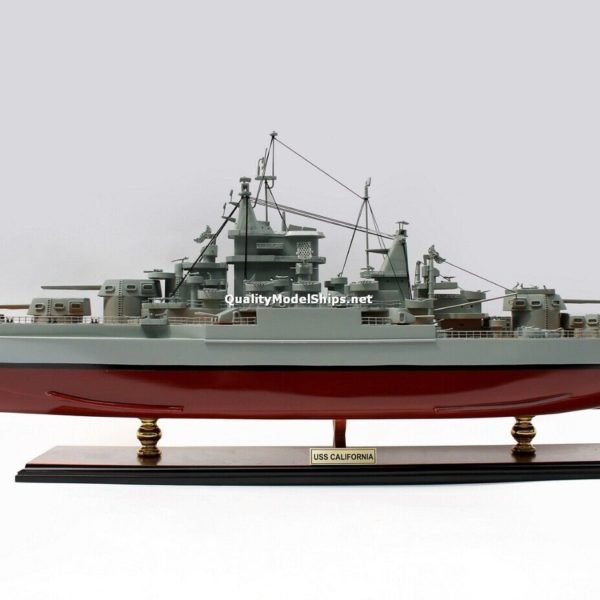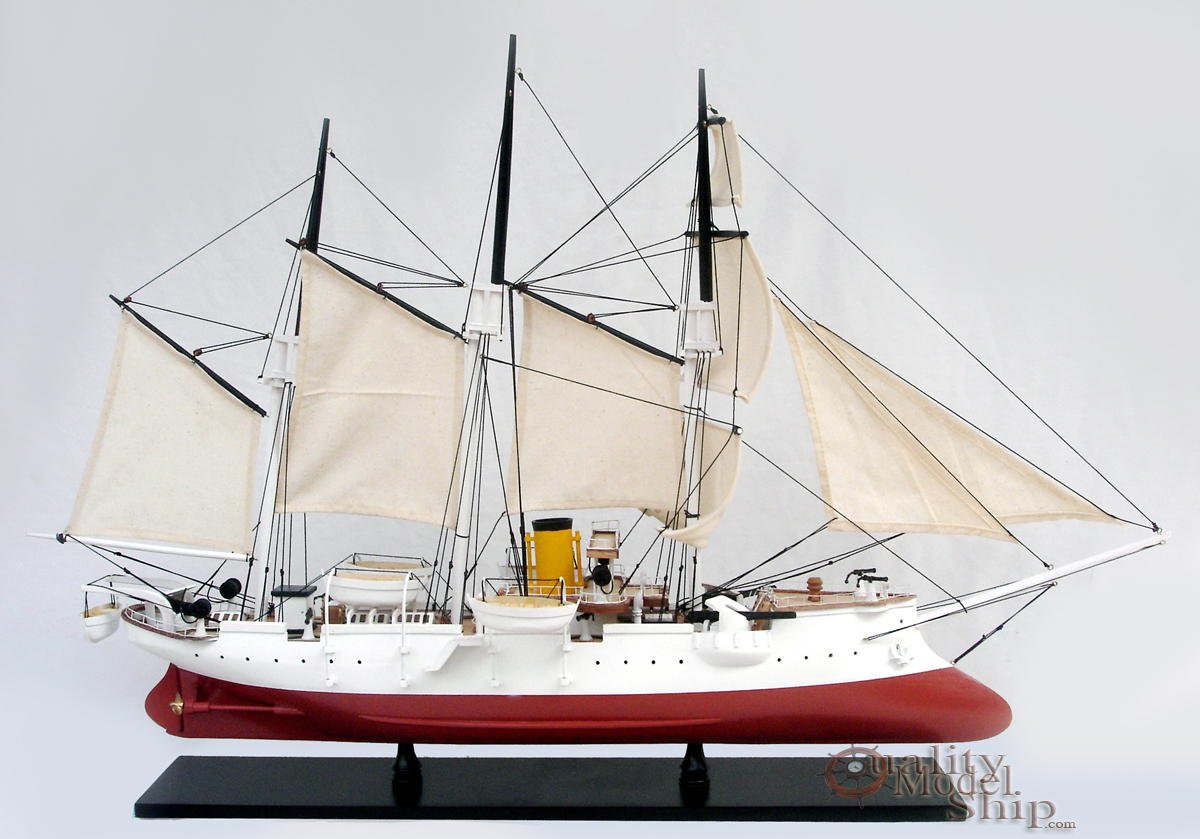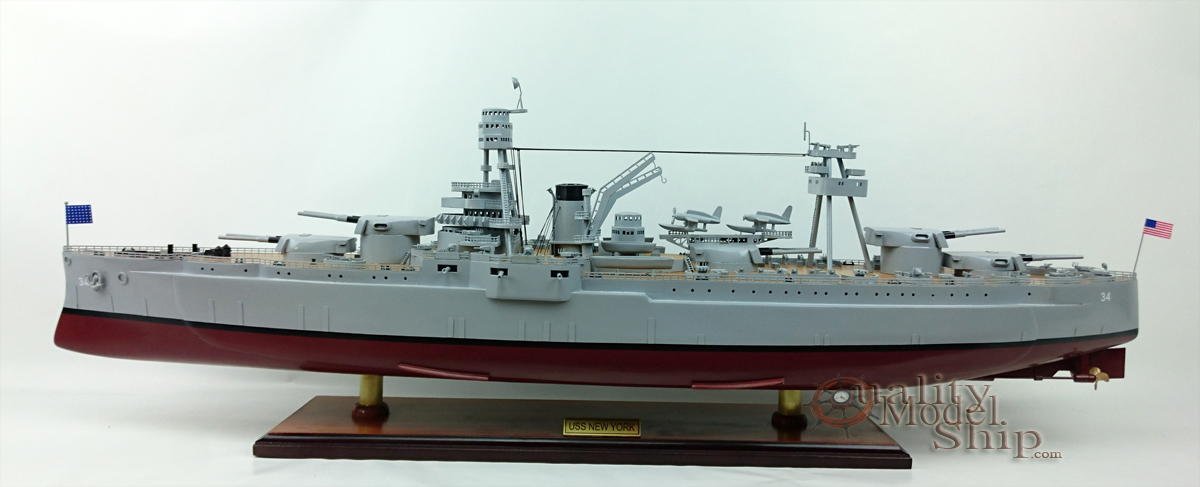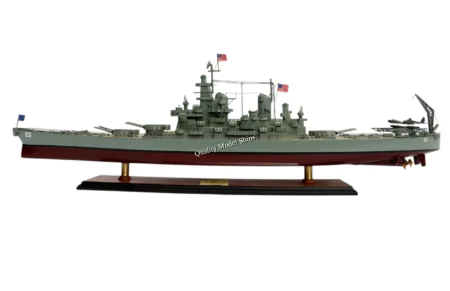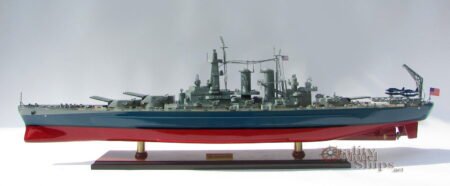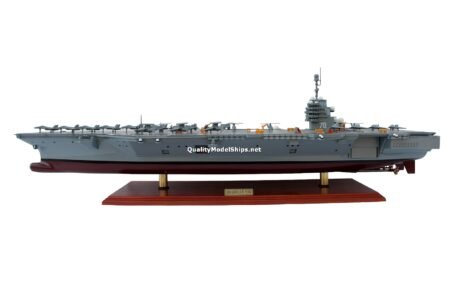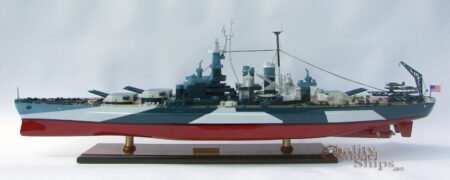| Content | • The model is 100% scratch built with planks on frame construction method from the drawings.
• The hull is made of wood and painted. This model is not a kit and ready for display.
• Model comes with a display base and a brass name plate as shown photos.
• Specifications approximate: 39.37L x 7.48W x 13.77H (inch) or 100L x 19W x 35H (cm)
• Brand new product.
• Item ship from Houston Texas by Standard shipping USPS/ UPS/ FedEx ground
• Buyer from Alaska, Puerto Rico or Hawaii please contact us for extra shipping cost.
• International buyer pays any duty/ import tax if any.
HISTORY
USS California (BB-44), one of two Tennessee-class battleships completed shortly after World War I, was the fifth ship of the United States Navy named in honor of the 31st state. She was the last American battleship built on the West Coast, and the only one to be a dreadnought type. She served in the Pacific her entire career, and for twenty years was the flagship of the Pacific Fleet. She was sunk in the attack on Pearl Harbor at her moorings in Battleship Row, but was salvaged and reconstructed. She served again for the remainder of World War II before being decommissioned in 1947. She was sold for scrap in 1959.
Construction and early service years
Her keel was laid down on 25 October 1916 by the Mare Island Naval Shipyard at Vallejo, California. She was launched 20 November 1919 sponsored by Mrs. R.T. (Barbara Stephens) Zane, daughter of California governor William D. Stephens; and commissioned on 10 August 1921, Captain Henry Joseph Ziegemeier in command. She immediately reported to the Pacific Fleet as flagship.
For 20 years, from 1921 to 1941, California served first as flagship of the Pacific Fleet, then as flagship of the Battle Fleet (Battle Force), US Fleet. Her annual activities included joint Army-Navy exercises, tactical and organizational development problems, and fleet concentrations for various purposes. Intensive training and superior performance won her the Battle Efficiency Pennant for 1921 and 1922, and the Gunnery "E" for 1925 and 1926.In the summer of 1925, California led the Battle Fleet and a division of cruisers from the Scouting Fleet on a good-will cruise to Australia and New Zealand. She took part in the Presidential reviews of 1927, 1930, and 1934. She was modernized in late 1929 and early 1930 and equipped with an improved anti-aircraft battery of eight 5 in (130 mm)/25 cal guns replacing the earlier 3 in (76 mm) guns. Also, the elevation of the ship's 14-inch guns was increased for improved range.
In the mid-to-late-1930s, California and the 14 battleships of the United States Fleet were stationed in San Pedro, California. During that time, they participated in numerous fleet exercises taking them up and down the West Coast, to Hawaii, and in 1939 through the Panama Canal, to Cuba, to New York City for the 1939 World's Fair.California was also active in sports competitions. Along with other Pacific Fleet battleships, her crew competed for the Navy Department General Excellency Trophy for Capital Ships of the Pacific Fleet – which because of its design quickly became known as the "Iron Man Trophy". Since 1919, the capital ships competed for this coveted award, which was awarded by COMSERVPAC on a system of points figured on the basis of participation and standings of athletic teams of ships of the Fleet. California was first awarded the "Iron Man" in 1924 and held it for three years. In 1939, California won the "Iron Man" for the last time with a total score of .733 to beat out New Mexico. During those years the competition for the "Iron Man" was fierce among the capital ships of the Pacific Fleet, until most of them were re-assigned to Hawaii in May 1940 after Fleet Problem XXI due to the growing concerns with relations with Japan. Competition for the trophy was suspended during the war, and was not revived until 1948, after California was out of commission.
California was one of six ships to receive the new RCA CXAM radar in 1940.
World War II
On 7 December 1941, California was moored at the southernmost berth of Battleship Row and was with other dreadnoughts of the Battle Force when the Japanese launched their aerial attack. Watertight integrity had been impaired by preparations for a material inspection; and the ship suffered extensive flooding damage when hit. One torpedo detonated below the armor belt between Frames 46 and 60, and a second detonated below the armor belt between Frames 95 and 100. At 0845, a 551 lb (250 kg) bomb entered the starboard upper deck level at Frame 60, passed through the main deck, and exploded on the armored second deck, setting off an anti-aircraft ammunition magazine and killing about 50 men. A second near miss bomb ruptured her bow plates. Smoke from fires started by the bomb hit caused evacuation of the forward engine-room at 1000 and ended pumping efforts to keep California afloat. After three days of progressive flooding, California settled into the mud with only her superstructure remaining above the surface. When the action ended, 100 of her crew were lost and 62 wounded. Machinist's Mate 1st Class Robert R. Scott was one of the sailors who lost his life on 7 December, refusing to leave his battle station, even as it flooded, "as long as the guns keep firing". Also killed was Chief Radioman Thomas Reeves who organized hand delivery of anti-aircraft ammunition when the equipment to lift it to the guns was knocked out. He was overcome by smoke and fire below decks while leading this effort. Both men were awarded the Medal of Honor posthumously for their heroism and Destroyer Escorts USS Reeves (DE-156) and USS Scott (DE-214) were named in their honor.
On 25 March 1942, California was refloated and dry-docked at Pearl Harbor for repairs. On 7 June, she departed under her own power for Puget Sound Navy Yard where a major reconstruction job was accomplished, including improved protection, watertight compartmenting, stability, antiaircraft battery, and fire control system. Her original twin funnels were combined into a single funnel faired into the superstructure tower as with the newer South Dakota class. The original 5 in (130 mm)/51 cal guns of the secondary battery and the 5 in (130 mm)/25 cal guns of the anti-aircraft battery were replaced by 16 5 in (130 mm)/38 cal guns in new twin mountings. Her appearance was nearly identical to that of Tennessee and West Virginia, which were rebuilt after the Pearl Harbor attack to resemble South Dakota-class battleships. Like her sisters, she was a virtually new ship built on the bones of the old.
As part of the two ocean navy policy, U.S. battleships had been designed within a beam constraint of 108 feet (33 m) in order to transit the Panama Canal; after their similar rebuilds, Tennessee, California and West Virginia were widened to 114 feet (35 m) feet, in effect limiting deployment to the Pacific theater.
California departed Bremerton, Washington on 31 January 1944 for shakedown at San Pedro, California, and sailed from San Francisco, California, on 5 May for the invasion of the Marianas. Off Saipan in June, she conducted effective shore bombardment and call fire missions. On 14 June, she was hit by a shell from an enemy shore battery which killed one man and wounded nine. Following Saipan, her heavy guns helped blast the way for the assault force in the Guam and Tinian operations from 18 July to 9 August. On 24 August she arrived at Espiritu Santo for repairs to her port bow damaged in a collision with her sister ship that was also present at Pearl Harbor with California, Tennessee.
On 17 September, California sailed to Manus to ready for the invasion of the Philippines. From 17 October to 20 November, she played a key role in the Leyte operation, including the destruction of the Japanese fleet in the Battle of Surigao Strait on 25 October. On 1 January 1945, she departed the Palaus for the Luzon landings. Her powerful batteries were an important factor in the success of these dangerous operations driven home into the heart of enemy-held territory under heavy air attack. On 6 January, while providing shore bombardment at Lingayen Gulf, she was hit by a kamikaze; 44 of her crew were killed and 155 were wounded. Undeterred she made temporary repairs on the spot and remained carrying out her critical mission of shore bombardment until the job was done. She departed on 23 January for Puget Sound Navy Yard, arriving on 15 February for permanent repairs.California returned to action at Okinawa on 15 June, and remained in that embattled area until 21 July. Two days later, she joined Task Force 95 (TF 95) to cover the East China Sea minesweeping operations. After a short voyage to San Pedro Bay (Philippines) in August, the ship departed Okinawa on 20 September to cover the landing of the Sixth Army occupation force at Wakanoura Wan, Honshū. She remained supporting the occupation until 15 October, then sailed via Singapore, Colombo, Ceylon, and Cape Town, South Africa, to Philadelphia, arriving on 7 December. She was placed in commission in reserve there on 7 August 1946, out of commission in reserve on 14 February 1947, stricken on 1 March 1959, and sold for scrapping on 10 July 1959 to Bethlehem Shipbuilding Corporation, Sparrows Point, Maryland.
Return/ Exchange Policy
• For some reasons if you wish to return the item, please consider not to open the item out of the wooden crate or open the item out of the styrofoam. You can open the carton box, lift up the whole wooden crate and check the models that are packed in wooden crate. For the items are packed in solid styrofoam, you can open the carton box, lift up the top part (styrofoam lid) and check the model. Please do not cut any strips or take the model out of the wooden crate or out of the styrofoam. It is very risky of damages to the item when you return if you open or remove the item out of the wooden crate or the styrofoam. We only accept and refund in full when the model return in good shape.
• Returned or exchanged products must be in brand-new, original condition, and have all original packaging, materials, and accessories .
• Buyer pays return shipping. | • The model is 100% scratch built with planks on frame construction method from the drawings.
• The hull is made of wood and painted. This model is not a kit and ready for display.
• Model comes with a display base and a brass name plate as shown photos.
• Specifications approximate: 43.30L x 10.62W x 21.25H (inch) or 110L x 27W x 54H (cm)
• Brand new product.
• Item ship from Houston Texas by Standard shipping USPS/ UPS/ FedEx ground
• Buyer from Alaska, Puerto Rico or Hawaii please contact us for extra shipping cost.
• International buyer pays any duty/ import tax if any.
HISTORY
Pelayo was an ironclad battleship of the Spanish Navy which served in the Spanish fleet from 1888 to 1925. She was the first battleship and the most powerful unit of the Spanish Navy. Despite its modern design for the time, Pelayo and the rest of the Spanish Asia-Pacific Rescue Squadron never engaged in combat during the Spanish–American War. Some historians argue the battleship, along with Armored Cruiser Carlos V, would have changed the course of the war dramatically, leading to a possible Spanish victory, thus consolidating Spain's status as a colonial power.
Return/ Exchange Policy
• For some reasons if you wish to return the item, please consider not to open the item out of the wooden crate or open the item out of the styrofoam. You can open the carton box, lift up the whole wooden crate and check the models that are packed in wooden crate. For the items are packed in solid styrofoam, you can open the carton box, lift up the top part (styrofoam lid) and check the model. Please do not cut any strips or take the model out of the wooden crate or out of the styrofoam. It is very risky of damages to the item when you return if you open or remove the item out of the wooden crate or the styrofoam. We only accept and refund in full when the model return in good shape.
• Returned or exchanged products must be in brand-new, original condition, and have all original packaging, materials, and accessories .
• Buyer pays return shipping.
| • The model is 100% scratch built with planks on frame construction method from the drawings.
• The hull is made of wood and painted. This model is not a kit and ready for display.
• Model comes with a display base and a brass name plate as shown photos.
• Specifications approximate: 39.37L x 6.30W x 11.81H (inch) or 100L x 16W x 30H (cm)
• Brand new product.
• Item ship from Houston Texas by Standard shipping USPS/ UPS/ FedEx ground
• Buyer from Alaska, Puerto Rico or Hawaii please contact us for extra shipping cost.
• International buyer pays any duty/ import tax if any.
Return/ Exchange Policy
• For some reasons if you wish to return the item, please consider not to open the item out of the wooden crate or open the item out of the styrofoam. You can open the carton box, lift up the whole wooden crate and check the models that are packed in wooden crate. For the items are packed in solid styrofoam, you can open the carton box, lift up the top part (styrofoam lid) and check the model. Please do not cut any strips or take the model out of the wooden crate or out of the styrofoam. It is very risky of damages to the item when you return if you open or remove the item out of the wooden crate or the styrofoam. We only accept and refund in full when the model return in good shape.
• Returned or exchanged products must be in brand-new, original condition, and have all original packaging, materials, and accessories .
• Buyer pays return shipping.
| • The model is 100% scratch built with planks on frame construction method from the drawings.
• The hull is made of wood and painted. This model is not a kit and ready for display. All the planes on decks are loose so you can arrange as you wish.
• Model comes with a display base.
• Specifications approximate: 37.79L x 11.81W x 11.81H (inch) or 96L x 30W x 30H (cm)
• Brand new product.
• Item ship from Houston Texas by Standard shipping USPS/ UPS/ FedEx ground
• Buyer from Alaska, Puerto Rico or Hawaii please contact us for extra shipping cost.
• International buyer pays any duty/ import tax if any.
Return/ Exchange Policy
• For some reasons if you wish to return the item, please consider not to open the item out of the wooden crate or open the item out of the styrofoam. You can open the carton box, lift up the whole wooden crate and check the models that are packed in wooden crate. For the items are packed in solid styrofoam, you can open the carton box, lift up the top part (styrofoam lid) and check the model. Please do not cut any strips or take the model out of the wooden crate or out of the styrofoam. It is very risky of damages to the item when you return if you open or remove the item out of the wooden crate or the styrofoam. We only accept and refund in full when the model return in good shape.
• Returned or exchanged products must be in brand-new, original condition, and have all original packaging, materials, and accessories .
• Buyer pays return shipping.
| • The model is 100% scratch built with planks-on-frame construction method. The hull is made of combination exotic wood stained that you can see the natural wood grains. The masts are full-rigged with full curl sails. It takes hundreds of hours to finish this model by skillful master craftsmen.
• The ornaments such as cannons, anchors, lamps are metal.
• Model is fully assembled and ready to display. The base included with the brass nameplate as show pictures.
• Dimensions overall length approximate 33.85L x 8.26W x 22.04H (inch) or 86L x 21W x 56H (cm)
• Buyer from Alaska, Puerto Rico, Hawaii or overseas, please contact us for shipping cost.
• International buyer pays any duty/ import tax.
HISTORY
Operational history
Korietz was laid down in Stockholm, Sweden at the Bergsund Mekaniksa shipyards in December 1885, launched on August 7, 1886, and commissioned in 1888.
Assigned to service with the Russian Pacific Fleet in 1895, she was a frequent visitor to ports in Korea, Japan and northern China. During the Boxer Rebellion, she participated in the Eight-Nation Alliance attack on Taku Forts on June 1900. During this battle, she was hit six times by shells fired by the Chinese defenders, and suffered nine crewmen killed and 20 wounded.
Together with the cruiser Varyag, Korietz was dispatched from Port Arthur to the main Korean port of Chemulpo (modern-day Incheon) in early 1904 to protect Russian interests, as diplomatic tensions continued to increase between Russia and the Empire of Japan. After the Russian transport Sungari arrived at Chemulpo on 7 February 1904, reporting the sighting of a large Japanese force approaching, Korietz (under the command of G. P. Belyaev) was ordered to return to Port Arthur to report and request instructions. In the early morning of 8 February 1904, Korietz spotted Chiyoda outside the Chemulpo roadstead, and mistaking it for a fellow Russian ship, loaded its guns for a salute. On closing in, the crew of the Korietz realized their mistake and in the ensuing confusion the guns were discharged. Chiyoda responded by launching a torpedo. Both sides missed, but this was the first actual exchange of fire in the Russo-Japanese War, and it is highly unclear which side actually opened fire first. Korietz retreated back to Chemulpo harbor.
In the subsequent Battle of Chemulpo Bay, Captain Vsevolod Rudnev of the Varyag refused an ultimatum by Imperial Japanese Navy admiral Uryū Sotokichi to surrender, and on February 9, 1904 attempted to break through the Japanese squadron from Chemulpo to the open sea. Vastly outnumbered and outgunned, Korietz fired 52 rounds at the Japanese ships, but was at a distance that most of its shots did not even reach the Japanese fleet. Varyag took heavy damage; Korietz suffered from only light damage from shrapnel with no casualties. Unable to break past the Japanese squadron by mid-afternoon, Korietz and Varyag returned to Chemulpo harbor, where both took refuge near the neutral warships. At 1600 the same day, Korietz was scuttled by its crew by blowing up two ammunition magazines. The crew was taken aboard a French cruiser Pascal, taken to Saigon, French Indochina, and returned to Russia. In St. Petersburg all the officers were awarded the Order of St. George (4th class), the highest military decoration of the Russian Empire.
After the end of the Russo-Japanese War, the wreckage of Korietz was raised by Japanese engineers, and scrapped.
Second gunboat
There was a second gunboat named Korietz, laid down in 1906 at the Putilov Plant in Saint Petersburg, Russia. She was of the Gilyak class. At the end of the First World War she participated in the Battle of Moon Sound, but was blown up by her crew on August 8, 1915 in to avoid having to be surrendered to German forces.
Return/ Exchange Policy
• For some reasons if you wish to return the item, please consider not to open the item out of the wooden crate or open the item out of the styrofoam. You can open the carton box, lift up the whole wooden crate and check the models that are packed in wooden crate. For the items are packed in solid styrofoam, you can open the carton box, lift up the top part (styrofoam lid) and check the model. Please do not cut any strips or take the model out of the wooden crate or out of the styrofoam. It is very risky of damages to the item when you return if you open or remove the item out of the wooden crate or the styrofoam. We only accept and refund in full when the model return in good shape.
• Returned or exchanged products must be in brand-new, original condition, and have all original packaging, materials, and accessories .
• Buyer pays return shipping.
• 15% restocking fee might apply.
| • The model is 100% scratch built with planks on frame construction method from the drawings.
• The hull is made of wood and painted. This model is not a kit and ready for display.
• Model comes with a display base and a brass name plate as shown photos.
• Specifications approximate: 35.43L x 7.48W x 11.81H (inch) or 90L x 19W x 30H (cm)
• Brand new product.
• Item ship from Houston Texas by Standard shipping USPS/ UPS/ FedEx ground
• Buyer from Alaska, Puerto Rico or Hawaii please contact us for extra shipping cost.
• International buyer pays any duty/ import tax if any.
HISTORY
USS New York (BB-34) was a United States Navy battleship, the lead ship of her class. Named for New York State, she was designed as the first ship to carry the 14-inch (356 mm)/45-caliber gun.
Entering service in 1914, she was part of the U.S. Navy force which was sent to reinforce the British Grand Fleet in the North Sea near the end of World War I. During that time, she was involved in at least two incidents with German U-boats, and is believed to have been the only US ship to have sunk one in the war, during an accidental collision in October 1918. Following the war, she was sent on a litany of training exercises and cruises in both the Atlantic and the Pacific, and saw several overhauls to increase her armament, aircraft handling and armor.
She entered the Neutrality Patrol at the beginning of World War II, and served as a convoy escort for ships to Iceland and Great Britain in the early phase of the war. She saw her first combat against coastal artillery during Operation Torch around Casablanca in North Africa, and later became a training ship. Late in the war, she moved to the Pacific, and provided naval gunfire support for the invasion of Iwo Jima and later the invasion of Okinawa. Returning to Pearl Harbor for repairs until the end of the war, she was classified obsolete and was chosen to take part in the Operation Crossroads nuclear weapon tests at Bikini Atoll in 1946. She survived both explosions and the effects of radiation on the ship were studied for several years. She was eventually sunk as a target in 1948. She received three battle stars for her service.
Return/ Exchange Policy
• For some reasons if you wish to return the item, please consider not to open the item out of the wooden crate or open the item out of the styrofoam. You can open the carton box, lift up the whole wooden crate and check the models that are packed in wooden crate. For the items are packed in solid styrofoam, you can open the carton box, lift up the top part (styrofoam lid) and check the model. Please do not cut any strips or take the model out of the wooden crate or out of the styrofoam. It is very risky of damages to the item when you return if you open or remove the item out of the wooden crate or the styrofoam. We only accept and refund in full when the model return in good shape.
• Returned or exchanged products must be in brand-new, original condition, and have all original packaging, materials, and accessories .
• Buyer pays return shipping.
|
